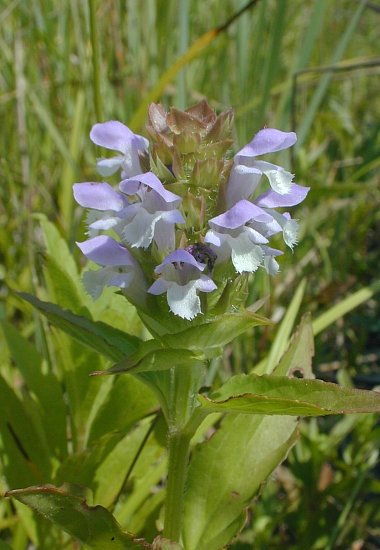Description:
This
short perennial wildflower is about ½–1' tall and unbranched. Two
varieties have been described, one of which is believed to be native to
North America,
including this one. The North American variety is said to be taller and
more
erect, with leaves that are lanceolate or wedge-shaped at the base. The
plant that is considered here has an erect central stem. This stem has
white hairs along its four angular ridges. The opposite leaves are up
to 2" long and ¾" across. They are broadly lanceolate or ovate, with
short petioles, and have scattered white hairs along the central vein
on their undersides. Their margins may be smooth, or they have
scattered
blunt teeth. The stem terminates in a short spike of flowers. Each
tubular flower is about ½" long and divided into 2 lips. The upper lip
is light purple and functions as a hood, while the lower lip is white
and fringed. The lower lip also has two lateral lobes that are smaller and light
purple. The
calyx is light green or reddish and quite hairy along the edges. There
is no noticeable floral scent. The blooming period occurs from mid- to
late summer and lasts about a month. Each flower produces 4 tiny brown,
angular, finely ridged seeds, which are enclosed in the persistent
calyx. Interestingly, the seeds may be distributed by raindrop
ballistics – when a raindrop strikes the ridged calyx tube, this causes
it to bend and rebound, flinging the seeds. The root system consists of
a short central taproot.
are smaller and light
purple. The
calyx is light green or reddish and quite hairy along the edges. There
is no noticeable floral scent. The blooming period occurs from mid- to
late summer and lasts about a month. Each flower produces 4 tiny brown,
angular, finely ridged seeds, which are enclosed in the persistent
calyx. Interestingly, the seeds may be distributed by raindrop
ballistics – when a raindrop strikes the ridged calyx tube, this causes
it to bend and rebound, flinging the seeds. The root system consists of
a short central taproot.
Cultivation:
The preference is full or partial sun, and moist to mesic conditions.
Some drought is tolerated, although the plant will respond by dropping
its lower leaves and turning greenish yellow. Growth is best in rich
loamy soil with high organic content, although other kinds of soil are
tolerated. This plant is easy to grow, and can become rather weedy and
aggressive.
Range & Habitat:
Self-Heal occurs in every county of Illinois and it is very common (see
Distribution
Map). This plant favors sites with a history of disturbance.
Habitats
include moist black soil prairies, moist meadows along streams,
thickets, openings in forests, woodland borders, pastures,
and abandoned fields. The variety of Self-Heal that is commonly
observed in lawns is thought to be the typical Eurasian variety. It is
shorter
and roots at the nodes of the leaves.
Faunal Associations:
The flowers are visited by long-tongued bees, short-tongued bees, small
butterflies (primarily Whites and Sulfurs), and skippers. Bee visitors
include bumblebees, Anthophorine bees, little carpenter bees (Ceratina
spp.), long-horned bees (Melissodes spp.),
and Halictid bees (including green metallic bees). These insects seek
nectar,
although the Halictid bees also collect pollen. Caterpillars
of the moth Agriopodes teratophora (Gray Marvel)
occasionally feed on the foliage. Self-Heal has a bitter taste and is
not favored by mammalian herbivores as a source of food. However,
livestock may eat this plant along with the grass.
Photographic Location:
The photograph was taken at the Red Bison Railroad Prairie in Savoy,
Illinois.
Comments:
This little plant is frequently more attractive in the wild than in
developed areas, where it is frequently attacked by the lawn mower,
yard trimmer, herbicides, and other instruments of destruction. Another
common name for this plant is 'All-Heal.' Some botanists refer to the
North American variety as Prunella vulgaris var. lanceolata.